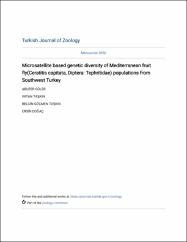Microsatellite based genetic diversity of Mediterranean fruit fly (Ceratitis capitata, Diptera: Tephritidae) populations from Southwest Turkey
Künye
GÜLER, ABUZER; TAŞKIN, VATAN; TAŞKIN, BELGİN GÖÇMEN; and DOĞAÇ, ERSİN (2022) "Microsatellite based genetic diversity of Mediterranean fruit fly(Ceratitis capitata, Diptera: Tephritidae) populations from Southwest Turkey," Turkish Journal of Zoology: Vol. 46: No. 3, Article 5. https://doi.org/10.55730/1300-0179.3056Özet
Various pests cause economic losses in some agricultural products, especially in citrus fruits, which are grown in many countries and have a very important role in consumption and export. The Mediterranean fruit fly, Ceratitis capitata Wied. (Diptera: Tephritidae), which spreads throughout the Mediterranean basin, Europe, the Middle East, Central, and South America, and Australia, is considered the most destructive pest in the world. Turkey is an important part of the Eastern Mediterranean basin and, maybe plays a role in the colonization of this pest. This polyphagous species causes huge economic losses by negatively affecting yield and quality in many countries. In this study, population genetic structure and inter-population relationships of the Mediterranean fruit fly were studied by using eight microsatellite markers sampled from the Mediterranean and Aegean regions of Turkey. The results represent a high level of genetic diversity in the Mediterranean fruit fly populations in Turkey and there is no geographical clustering observed when the populations are evaluated in the geographical sense. As a result of the study for 7 provinces, the average number of alleles (na) was 6.95, the average number of effective alleles (ne) was 3.58, the observed (Ho) and expected (He) heterozygosity values were 0.61 and 0.67, respectively. The gene flow (Nem) level among populations was found as Nem = 1.13. Higher genetic diversity values point out that Turkey may have an important role in the colonization of this organism.


















